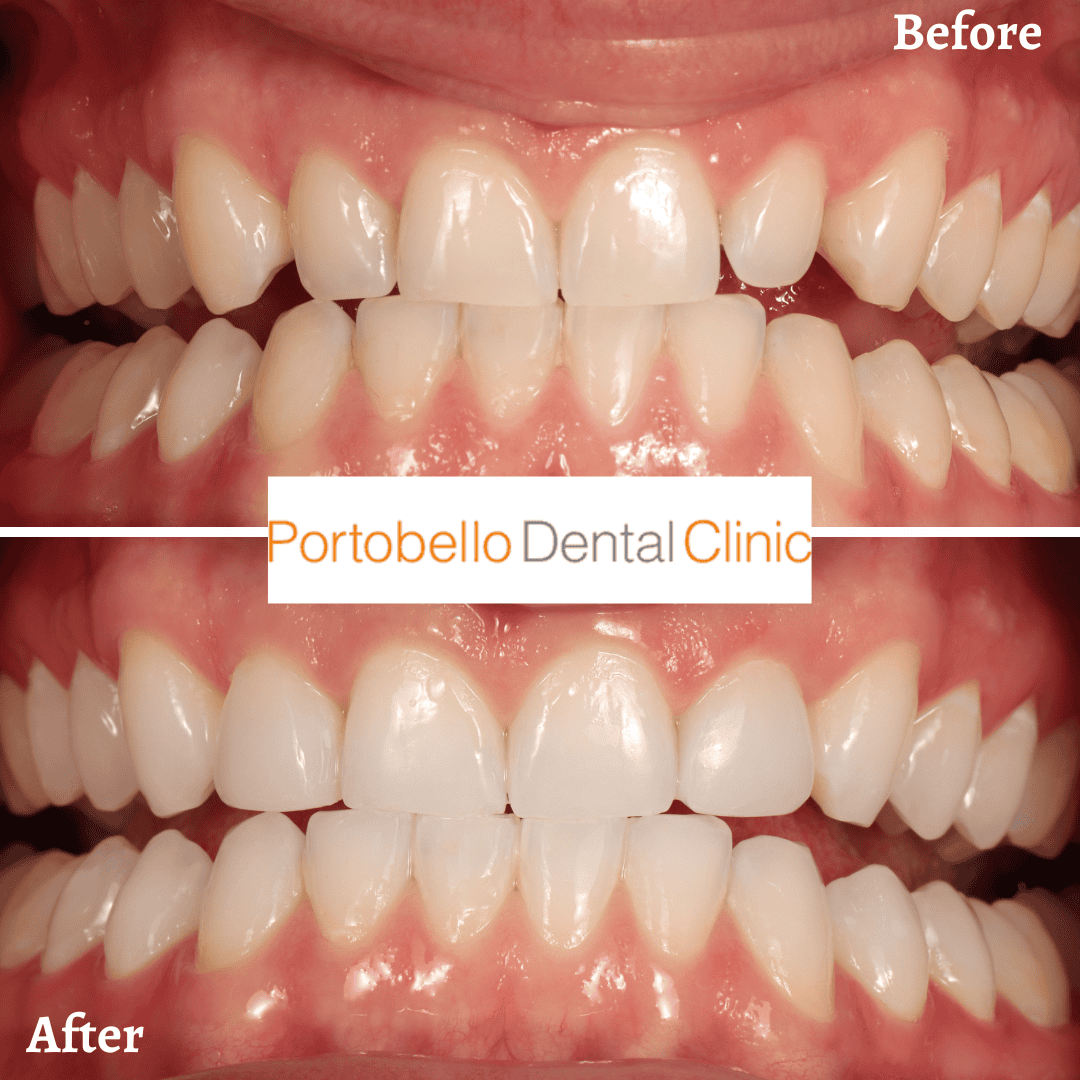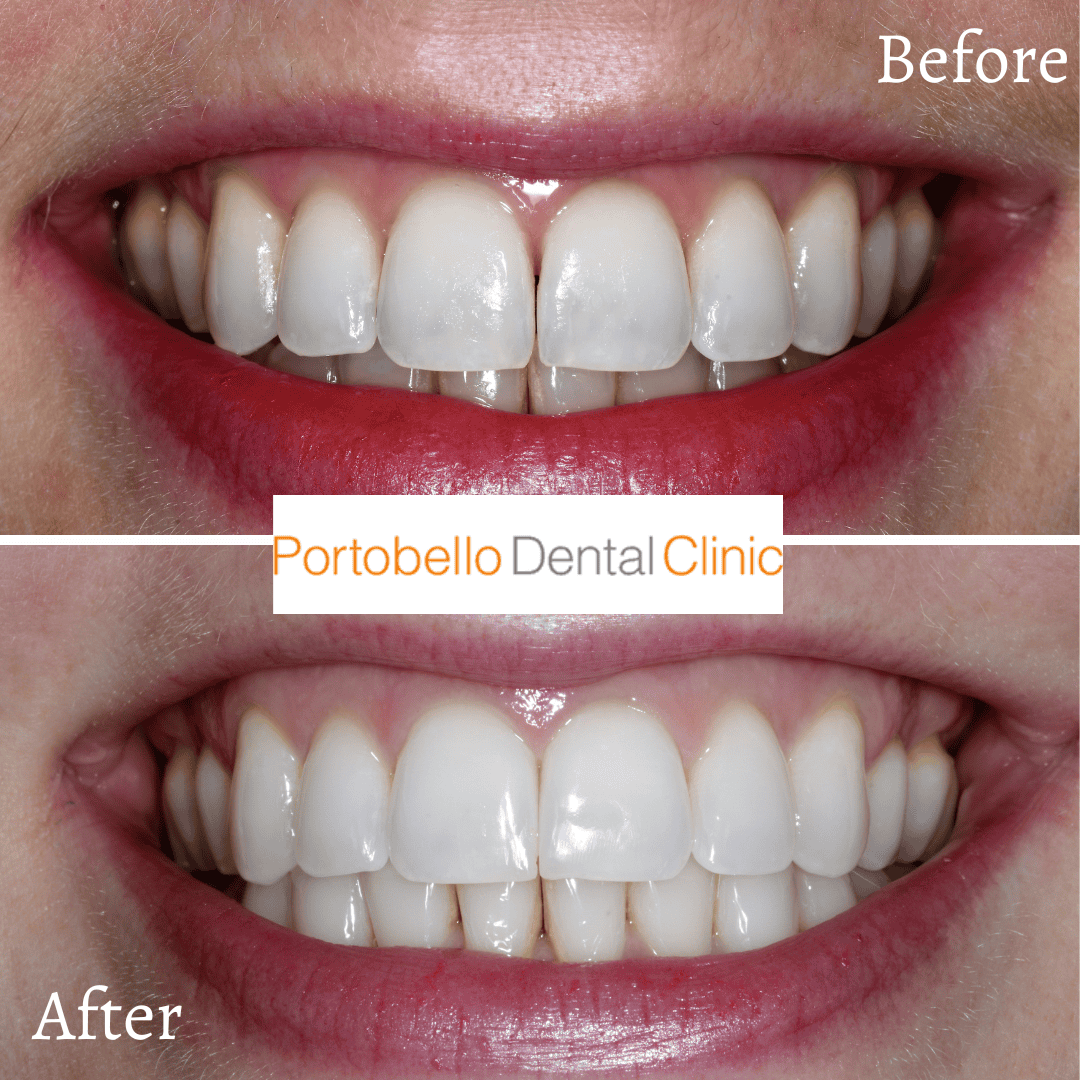Cosmetic dental bonding is a popular treatment that enhances the appearance of your teeth quickly and effectively. Whether you have minor imperfections or are looking for a more aesthetically pleasing smile, bonding can be a solution. Let’s explore what cosmetic bonding involves, why it might be used, and answer some of the most frequently asked questions about the procedure.
What is Cosmetic Bonding?
Cosmetic bonding is a dental procedure where a tooth-coloured resin material is applied to teeth to correct imperfections. The resin is moulded and hardened to the natural shape of the tooth, improving both its look and function.
Although technically demanding for the dentists, the treatments are also quick and comfortable for patients, and in the vast majority of cases a single session is all that’s required.
Why Might Cosmetic Bonding Be Used?

A 2024 cosmetic bonding and teeth whitening case carried out by Dr Stephen Taylor
Cosmetic bonding is a versatile solution for several dental concerns. Here are some reasons why someone might choose cosmetic bonding:
- Chipped or Broken Teeth: If a tooth has a small chip or break, bonding can restore its appearance by filling in the gap with the resin material.
- Discoloured Teeth: Bonding can cover stains or discoloration on teeth, especially if whitening treatments haven’t worked.
- Gaps Between Teeth: For patients with small gaps between their teeth, cosmetic bonding can be used to fill in the spaces and create a more uniform smile.
- Misshapen or Irregular Teeth: Bonding can be used to improve the shape and size of teeth that are uneven or unusually shaped.
Frequently Asked Questions About Cosmetic Bonding
Is cosmetic bonding painful?
No, cosmetic bonding is generally not painful. The procedure is minimally invasive, and most patients don’t require anaesthesia. However, if the bonding is used to fill a cavity, the dentist may apply a local anaesthetic to numb the area.
How long does cosmetic bonding last?
Cosmetic bonding typically lasts between 5 to 7 years, depending on your oral hygiene habits and the location of the bonded tooth. Bonding on teeth that experience heavy wear, like molars, may wear down faster than bonding on front teeth.
How do I care for my bonded teeth?
After the procedure, it’s important to maintain good oral hygiene by brushing and flossing regularly. Be mindful of biting into hard foods, as bonded teeth can chip or wear down. Avoid habits like nail-biting or using teeth to open packages, as this can damage the bonding material. It’s important to also attend your dentist and hygienist regularly.
Does cosmetic bonding look natural?

A 2022 case by Dr Helen Walsh of Invisalign Go orthodontic treatment, followed by composite bonding.
Yes! The resin used in cosmetic bonding can be matched to the natural colour of your teeth, making the result look seamless. Our skilled dentists will ensure that the shape, texture, and colour of the bonded tooth blend well with your smile.
Can bonding be done in one visit?
Yes, most cosmetic bonding procedures can be completed in a single visit, especially if it’s being done for cosmetic purposes. However, if it’s being used for more extensive restoration, such as filling cavities, the process may take longer. After your initial consultation with the dentist, they will plan for how many appointments it may take. If a patient chooses to whiten, prior to having cosmetic bonding, the whitening process requires a minimum of two weeks.
Are there any risks with cosmetic bonding?
Like any dental procedure, there are some risks. The bonding material can become stained over time, especially if you smoke or drink coffee or wine regularly. Additionally, while the bonding material is durable, it’s not as strong as your natural tooth enamel, so it can chip or crack with excessive force or pressure.
Is cosmetic bonding right for me?
Cosmetic bonding is suitable for many patients with mild to moderate cosmetic concerns. It’s an excellent choice if you’re looking for a quick, affordable solution to improve your smile. However, for more significant dental issues, such as missing teeth, crowns or veneers may be more appropriate. Your dentist will be able to recommend the best treatment based on your needs.
How do I make an appointment?

Cosmetic Bonding used to close a midline diastema by Dr Daniel Browne
The first step is to book a comprehensive dental assessment with one of our dentists. This includes a full dental examination, any necessary x-rays and/or photos, oral cancer screening, gum examination, consultation, and treatment plan. Your dentist will determine at this appointment if you are a suitable candidate for cosmetic bonding.
To book in for an appointment please contact us on (01) 454 2022, email us on info@portobellodental.com or alternatively if you would like to book an appointment online, you can book here.
If you have any questions regarding the treatment our team are here to help and you can also arrange a phone consultation with our Treatment Coordinator, Anne-Marie, who can discuss cosmetic bonding in more detail with you:
